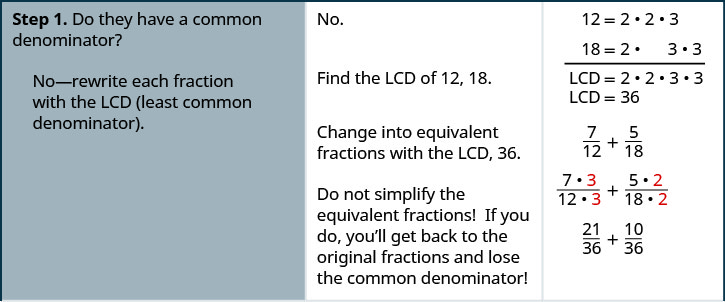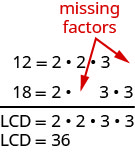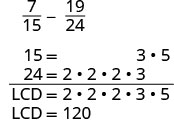CHAPTER 2 Operations with Rational Numbers and Introduction to Real Numbers
2.2 Add and Subtract Fractions
Learning Objectives
By the end of this section, you will be able to:
- Add or subtract fractions with a common denominator
- Add or subtract fractions with different denominators
- Use the order of operations to simplify complex fractions
- Evaluate variable expressions with fractions
Add or Subtract Fractions with a Common Denominator
When we multiplied fractions, we just multiplied the numerators and multiplied the denominators right straight across. To add or subtract fractions, they must have a common denominator.
Fraction Addition and Subtraction
If ![]() are numbers where
are numbers where ![]() , then
, then
![]()
To add or subtract fractions, add or subtract the numerators and place the result over the common denominator.
EXAMPLE 1
Find the sum: ![]() .
.
| Add the numerators and place the sum over the common denominator. |
TRY IT 1.1
Find the sum: ![]() .
.
Show answer
![]()
TRY IT 1.2
Find the sum: ![]() .
.
Show answer
![]()
EXAMPLE 2
Find the difference: ![]() .
.
| Subtract the numerators and place the difference over the common denominator. | |
| Simplify. | |
| Simplify. Remember, |
TRY IT 2.1
Find the difference: ![]() .
.
Show answer
![]()
TRY IT 2.2
Find the difference: ![]() .
.
Show answer
![]()
EXAMPLE 3
Simplify: ![]() .
.
| Subtract the numerators and place the difference over the common denominator. | |
| Rewrite with the sign in front of the fraction. |
TRY IT 3.1
Find the difference: ![]() .
.
Show answer
![]()
TRY IT 3.2
Find the difference: ![]() .
.
Show answer
![]()
Now we will do an example that has both addition and subtraction.
EXAMPLE 4
Simplify: ![]() .
.
| Add and subtract fractions—do they have a common denominator? Yes. | |
| Add and subtract the numerators and place the difference over the common denominator. | |
| Simplify left to right. | |
| Simplify. |
TRY IT 4.1
Simplify: ![]() .
.
Show answer
![]()
TRY IT 4.2
Simplify: ![]() .
.
Show answer
![]()
Add or Subtract Fractions with Different Denominators
As we have seen, to add or subtract fractions, their denominators must be the same. The least common denominator (LCD) of two fractions is the smallest number that can be used as a common denominator of the fractions. The LCD of the two fractions is the least common multiple (LCM) of their denominators.
Least Common Denominator
The least common denominator (LCD) of two fractions is the least common multiple (LCM) of their denominators.
After we find the least common denominator of two fractions, we convert the fractions to equivalent fractions with the LCD. Putting these steps together allows us to add and subtract fractions because their denominators will be the same!
EXAMPLE 5
Add: ![]() .
.



TRY IT 5.1
Add: ![]() .
.
Show answer
![]()
TRY IT 5.2
Add: ![]() .
.
Show answer
![]()
HOW TO: Add or Subtract Fractions
- Do they have a common denominator?
- Yes—go to step 2.
- No—rewrite each fraction with the LCD (least common denominator). Find the LCD. Change each fraction into an equivalent fraction with the LCD as its denominator.
- Add or subtract the fractions.
- Simplify, if possible.
When finding the equivalent fractions needed to create the common denominators, there is a quick way to find the number we need to multiply both the numerator and denominator. This method works if we found the LCD by factoring into primes.
Look at the factors of the LCD and then at each column above those factors. The “missing” factors of each denominator are the numbers we need.

In (Example 5), the LCD, 36, has two factors of 2 and two factors of ![]() .
.
The numerator 12 has two factors of 2 but only one of 3—so it is “missing” one 3—we multiply the numerator and denominator by 3
The numerator 18 is missing one factor of 2—so we multiply the numerator and denominator by 2
We will apply this method as we subtract the fractions in (Example 6).
EXAMPLE 6
Subtract: ![]() .
.
Do the fractions have a common denominator? No, so we need to find the LCD.
Find the LCD. |
|
| Notice, 15 is “missing” three factors of 2 and 24 is “missing” the 5 from the factors of the LCD. So we multiply 8 in the first fraction and 5 in the second fraction to get the LCD. | |
| Rewrite as equivalent fractions with the LCD. |  |
| Simplify. |  |
| Subtract. | |
| Check to see if the answer can be simplified. | |
| Both 39 and 120 have a factor of 3. | |
| Simplify. |
Do not simplify the equivalent fractions! If you do, you’ll get back to the original fractions and lose the common denominator!
TRY IT 6.1
Subtract: ![]() .
.
Show answer
![]()
TRY IT 6.2
Subtract: ![]() .
.
Show answer
![]()
In the next example, one of the fractions has a variable in its numerator. Notice that we do the same steps as when both numerators are numbers.
EXAMPLE 7
Add: ![]() .
.
The fractions have different denominators.
 |
||
Find the LCD. |
||
| Rewrite as equivalent fractions with the LCD. |  |
|
| Simplify. |  |
|
| Add. |  |
TRY IT 7.1
Add: ![]() .
.
Show answer
![]()
TRY IT 7.2
Add: ![]() .
.
Show answer
![]()
We now have all four operations for fractions. The table below summarizes fraction operations.
| Fraction Operation | Sample Equation | What to Do |
|---|---|---|
| Fraction multiplication | Multiply the numerators and multiply the denominators | |
| Fraction division | Multiply the first fraction by the reciprocal of the second. | |
| Fraction addition | Add the numerators and place the sum over the common denominator. | |
| Fraction subtraction | Subtract the numerators and place the difference over the common denominator. |
To multiply or divide fractions, an LCD is NOT needed. To add or subtract fractions, an LCD is needed.
EXAMPLE 8
Simplify: a) ![]() b)
b) ![]() .
.
Solution
First ask, “What is the operation?” Once we identify the operation that will determine whether we need a common denominator. Remember, we need a common denominator to add or subtract, but not to multiply or divide.
| a) What is the operation? The operation is subtraction. | |
| Do the fractions have a common denominator? No. | |
| Rewrite each fraction as an equivalent fraction with the LCD. |
|
| Subtract the numerators and place the difference over the common denominators. | |
| Simplify, if possible. | There are no common factors. The fraction is simplified. |
| b) What is the operation? Multiplication. | |
| To multiply fractions, multiply the numerators and multiply the denominators. | |
| Rewrite, showing common factors. Remove common factors. | |
| Simplify. |
Notice we needed an LCD to add ![]() , but not to multiply
, but not to multiply ![]() .
.
TRY IT 8.1
Simplify. a) ![]() b)
b) ![]()
Show answer
a) ![]() b)
b) ![]()
TRY IT 8.2
Simplify: a) ![]() b)
b) ![]() .
.
Show answer
a) ![]() b)
b) ![]()
Use the Order of Operations to Simplify Complex Fractions
We have seen that a complex fraction is a fraction in which the numerator or denominator contains a fraction. The fraction bar indicates division. We simplified the complex fraction ![]() by dividing
by dividing ![]() by
by ![]() .
.
Now we’ll look at complex fractions where the numerator or denominator contains an expression that can be simplified. So we first must completely simplify the numerator and denominator separately using the order of operations. Then we divide the numerator by the denominator.
EXAMPLE 9
Simplify: ![]() .
.



TRY IT 9.1
Simplify: ![]() .
.
Show answer
![]()
TRY IT 9.2
Simplify: ![]() .
.
Show answer
![]()
HOW TO: Simplify Complex Fractions
- Simplify the numerator.
- Simplify the denominator.
- Divide the numerator by the denominator. Simplify if possible.
EXAMPLE 10
Simplify: ![]() .
.
It may help to put parentheses around the numerator and the denominator.
| Simplify the numerator (LCD = 6) and simplify the denominator (LCD = 12). | |
| Simplify. | |
| Divide the numerator by the denominator. | |
| Simplify. | |
| Divide out common factors. | |
| Simplify. |
TRY IT 10.1
Simplify: ![]() .
.
Show answer
2
TRY IT 10.2
Simplify: ![]() .
.
Show answer
![]()
Evaluate Variable Expressions with Fractions
We have evaluated expressions before, but now we can evaluate expressions with fractions. Remember, to evaluate an expression, we substitute the value of the variable into the expression and then simplify.
EXAMPLE 11
Evaluate ![]() when a)
when a) ![]() b)
b) ![]() .
.
- To evaluate
 when
when  , substitute
, substitute  for
for  in the expression.
in the expression.



Simplify. 
0 - To evaluate
 when
when  , we substitute
, we substitute  for x in the expression.
for x in the expression.



Rewrite as equivalent fractions with the LCD, 12. 
Simplify. 
Add. 
TRY IT 11.1
Evaluate ![]() when a)
when a) ![]() b)
b) ![]() .
.
Show answer
a) ![]() b)
b) ![]()
TRY IT 11.2
Evaluate ![]() when a)
when a) ![]() b)
b) ![]() .
.
Show answer
a) ![]() b)
b) ![]()
EXAMPLE 12
Evaluate ![]() when
when ![]() .
.
 |
|
 |
 |
| Rewrite as equivalent fractions with the LCD, 6. |  |
| Subtract. |  |
| Simplify. |
TRY IT 12.1
Evaluate ![]() when
when ![]() .
.
Show answer
![]()
TRY IT 12.2
Evaluate ![]() when
when ![]() .
.
Show answer
![]()
EXAMPLE 13
Evaluate ![]() when
when ![]() and
and ![]() .
.
Substitute the values into the expression.
 |
 |
| Simplify exponents first. | |
| Multiply. Divide out the common factors. Notice we write 16 as |
|
| Simplify. |
TRY IT 13.1
Evaluate ![]() when
when ![]() and
and ![]() .
.
Show answer
![]()
TRY IT 13.2
Evaluate ![]() when
when ![]() and
and ![]() .
.
Show answer
![]()
The next example will have only variables, no constants.
EXAMPLE 14
Evaluate ![]() when
when ![]() .
.
To evaluate ![]() when
when ![]() , we substitute the values into the expression.
, we substitute the values into the expression.
 |
 |
| Add in the numerator first. | |
| Simplify. |
TRY IT 14.1
Evaluate ![]() when
when ![]() .
.
Show answer
![]()
TRY IT 14.2
Evaluate ![]() when
when ![]() .
.
Show answer
![]()
Key Concepts
- Fraction Addition and Subtraction: If
 are numbers where
are numbers where  , then
, then
 and
and  .
.
To add or subtract fractions, add or subtract the numerators and place the result over the common denominator. - Strategy for Adding or Subtracting Fractions
- Do they have a common denominator?
Yes—go to step 2.
No—Rewrite each fraction with the LCD (Least Common Denominator). Find the LCD. Change each fraction into an equivalent fraction with the LCD as its denominator. - Add or subtract the fractions.
- Simplify, if possible. To multiply or divide fractions, an LCD IS NOT needed. To add or subtract fractions, an LCD IS needed.
- Do they have a common denominator?
- Simplify Complex Fractions
- Simplify the numerator.
- Simplify the denominator.
- Divide the numerator by the denominator. Simplify if possible.
Glossary
- least common denominator
- The least common denominator (LCD) of two fractions is the Least common multiple (LCM) of their denominators.
Practice Makes Perfect
Add and Subtract Fractions with a Common Denominator
In the following exercises, add.
| 1. |
2. |
| 3. |
4. |
| 5. |
6. |
| 7. |
8. |
| 9. |
10. |
| 11. |
12. |
| 13. |
14. |
| 15. |
16. |
| 17. |
18. |
| 19. |
20. |
| 21. |
22. |
| 23. |
24. |
Mixed Practice
In the following exercises, simplify.
| 25. |
26. |
| 27. |
28. |
| 29. |
30. |
| 31. |
32. |
Add or Subtract Fractions with Different Denominators
In the following exercises, add or subtract.
| 33. |
34. |
| 35. |
36. |
| 37. |
38. |
| 39. |
40. |
| 41. |
42. |
| 43. |
44. |
| 45. |
46. |
| 47. |
48. |
| 49. |
50. |
| 51. |
52. |
| 53. |
54. |
| 55. |
56. |
Mixed Practice
In the following exercises, simplify.
| 57. a) |
58. a) |
| 59. a) |
60. a) |
| 61. |
62. |
| 63. |
64. |
| 65. |
66. |
| 67. |
68. |
| 69. |
70. |
Use the Order of Operations to Simplify Complex Fractions
In the following exercises, simplify.
| 71. |
72. |
| 73. |
74. |
| 75. |
76. |
| 77. |
78. |
| 79. |
80. |
| 81. |
82. |
| 83. |
84. |
| 85. |
86. |
| 87. |
88. |
| 89. |
90. |
| 91. |
92. |
Evaluate Variable Expressions with Fractions
In the following exercises, evaluate.
| 93. a) b) |
94. a) b) |
| 95. a) b) |
96. a) b) |
| 97. a) b) |
98. a) b) |
| 99. |
100. |
| 101. |
102. |
Everyday Math
| 103. Decorating Laronda is making covers for the throw pillows on her sofa. For each pillow cover, she needs |
104. Baking Samuel is baking chocolate chip cookies and oatmeal cookies. He needs |
Writing Exercises
| 105. Why do you need a common denominator to add or subtract fractions? Explain. | 106. How do you find the LCD of 2 fractions? |
Answers
| 1. |
3. |
5. |
| 7. |
9. |
11. |
| 13. |
15. |
17. |
| 19. |
21. |
23. |
| 25. |
27. |
29. |
| 31. |
33. |
35. |
| 37. |
39. |
41. |
| 43. |
45. |
47. |
| 49. |
51. |
53. |
| 55. |
57. a) |
59. a) |
| 61. |
63. |
65. |
| 67. |
69. |
71. 54 |
| 73. |
75. |
77. |
| 79. |
81. |
83. |
| 85. |
87. |
89. 1 |
| 91. |
93. a) |
95. a) |
| 97. a) |
99. |
101. |
| 103. |
105. Answers may vary |
Attributions
This chapter has been adapted from “Add and Subtract Fractions” in Elementary Algebra (OpenStax) by Lynn Marecek and MaryAnne Anthony-Smith, which is under a CC BY 4.0 Licence. Adapted by Izabela Mazur. See the Copyright page for more information.

